Three canals cross the Pennines, each with its own character, but all showing the determination of two centuries ago to get goods moving across the hills and build prosperity. Today you can see their history all around as you travel, but also how the West Riding is adapting to 21st century life. Our base among the old warehouses of Sowerby Bridge Wharf is ideally situated for exploring all the northern waterways.
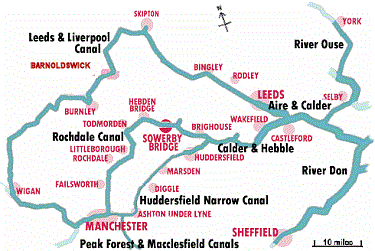 Suggested Routes:
Suggested Routes:We have routes to suit all levels of experience from newcomers to those who have been boating for decades. Choose from:
Out & Back 7 night holidays
Longer trips 11-14 nights
On other boats, we also offer:
Short Breaks 3- 4 nights
One Way Trips 7 nights
Walsden & Brighouse 37 miles 76 locks 30 hours
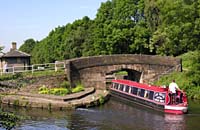
Leaving our historic canal basin, your journey begins with the excitement of a new tunnel and the deepest lock in the country. The canal gradually climbs through woods, fields and small stone towns to Hebden Bridge. This old mill town nestles in a fork in the hills, houses piled tier upon tier. Hebden has excellent shops and is full of surprises - everything from horsey clothing to hand-made pottery. Untie, and go on up the valley, its sides closing in with crags and trees and views of the moors high above. A stream runs alongside, and the locks are set among woods or stone cottages. The Pennine Way crosses at Callis. So to Todmorden, completely untouristy yet with much to enjoy - fine Victorian buildings, especially the Town Hall, a lively market and many places to eat and drink, all dominated by a curving railway viaduct. From here the going gets serious – more Alpine than Pennine. Pass the Great Wall of Todmorden, and go under a splendidly overdone Gothic railway bridge. Turn at Lock 32, below below the summit. On your return trip, go down the Calder Valley through the woods to Brighouse. Good shopping, including a Sainsbury's with its own moorings, plentiful pubs and time to relax. Finally, make your way back to base.
Selby 96 miles 68 locks 40 hours
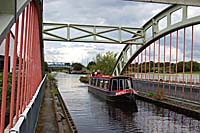
Sail down the leafy Calder & Hebble Navigation past Brighouse, and through wide river sections and narrow cuttings to Wakefield, where there are good moorings not too far from the bright lights. Then on to Stanley Ferry to see the famous aqueducts (see picture) and two very convenient and contrasting pubs. You are now on the Aire & Calder, which is still a thriving commercial waterway, though there are now many more pleasure boats than barges. Go to Castleford, a Roman river crossing, and keep on the main line of the Aire & Calder Navigation towards Knottingley. This section briefly passes through an industrial hinterland, but is full of interest because of the water-borne freight which comes through. At Bank Dole you leave the main line and its electric locks, to drop into the Aire as it winds through farmland, stopping occasionally at pretty brick-built villages. And so to Selby, where you can explore the ancient Abbey and market, before taking the train to York – you could have time for a full day there. This return trip is relatively easy.
Rochdale 42 miles 98 locks 45 hours

This enables you to cross the summit, the second highest (just) in England at 600’. Take the Route above to Todmorden, and go on to the summit. Pause at the Summit Inn, your first in Lancashire, before making the steep drop into Littleborough, 12 locks in 2 miles. Visit the second-hand bookshop, then go on past Clegg Hall (a Grade 2* listed restored ruin built in 1618) and pass through the outskirts of Rochdale - already surprisingly sylvan - and to its centre. Carry on to Lock No. 50, and turn just below.
Navigation notes: This journey is recommended for experienced crews only. We will give further details in the Information Pack posted to you before your holiday.
Marsden (bottom of flight) 39 miles 108 locks 40 hours
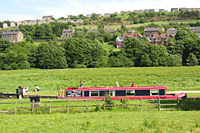
Sail down the Calder & Hebble Navigation past Brighouse, with a short river section to Cooper Bridge, where you take the right turn into the bottom lock of the Huddersfield Broad. This leads you up through the outskirts of Huddersfield right into the City centre. Go through the University, a weird but satisfying juxtaposition of sixties high-rise and nineties mill conversion, then dive under another mill (this one real) into the first of two new tunnels which lead directly into new locks. As you emerge, a steel-truss railway viaduct frames the start of your journey up the Colne valley into the hills. At Slaithwaite the canal has been put back on its original track. You will enjoy exploring the village. Then go on up the valley. Leave your boat at Lock 31E, the bottom of Marsden flight, and walk up to see Marsden itself. The Mechanics Institute is the home of Mikron Theatre (though they will be away touring). Walk on to the summit, 644’ 9” above sea level, where a very short pool makes the entrance into Standedge Tunnel all the more dramatic by its understatement. The Standedge Visitor Centre gives an insight into the lives of the tunnellers who blasted their way under the Pennines, the packhorse teams who preceded them over the top, and the leggers who took the boats through 3 ¼ miles of pitch dark. You can take a short trip into the tunnel in an electric boat, before returning to your own and heading back.
Navigation notes: This canal is recommended for experienced crews only. We will give further details in the Information Pack posted to you before your holiday. The furthest possible point for a week's return holiday is Marsden; passage through Standedge Tunnel isn't feasible on your own boat, but a public trip may be available from CRT.
Bingley 5-rise 110 miles 118 locks 55 hours
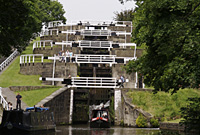
Turn left at Castleford (see above), where electric locks and a wide channel help you speed (relatively) round to Leeds, where you sail past the regenerated waterfront. Then join the Leeds & Liverpool Canal which quickly escapes along its own way through fields and woods, with spectacular views of old West Riding industry - particularly Sir Titus Salt's Italianate mills and model town at Saltaire, with its Hockney museum. There are several staircase locks along the way, which culminate in the Five Rise Locks at Bingley, one of the Seven Wonders of the Waterways and a fitting climax to your journey. Return the same way; this is a very energetic trip for the more experienced.
Longer trips
11 to 14 nights
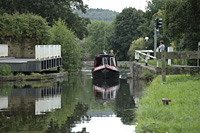
Sail down the leafy Calder & Hebble Navigation past Brighouse, and through wide river sections and narrow cuttings to Wakefield, where there are good moorings not too far from the bright lights. Then on to Stanley Ferry to see the famous aqueducts and two very convenient and contrasting pubs.
You are now on the Aire & Calder, which is still a thriving commercial waterway, though there are now many more pleasure boats than barges. Electric locks and a wide channel help you speed (relatively) round to Leeds, where you sail past the regenerated waterfront.
Then join the Leeds & Liverpool Canal which quickly escapes along its own way through fields and woods, with spectacular views of old West Riding industry - particularly Sir Titus Salt's Italianate mills and model town at Saltaire, with its Hockney museum. There are several staircase locks along the way, which culminate in the Five Rise Locks at Bingley, one of the Seven Wonders of the Waterways.
Carry on along the hillside, with views of the wide Aire valley to one side, and the edge of the Yorkshire Dales National Park on the other. Pretty villages and lots of swing bridges - much easier these days - take you through to Skipton, Gateway to the Dales. Don't miss the castle! This return journey needs long days and good timing.
The
South Pennine Ring 71 miles 197 locks 80
hours.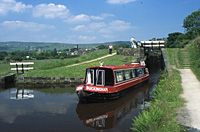
This exhilarating journey crosses the Pennines twice. You need to plan
carefully so as arrive on time for passages in three different places
which you must book: Standedge Tunnel, and Locks 66 to 83 and 36 to 37
on the Rochdale. This trip is achievable in eleven nights (ten does not
work), but because you should allow some time for possible delays, it is
much more comfortable in a fortnight - which should leave you a little
spare time to visit the Peak Forest Canal.
Sail
down the Calder & Hebble Navigation past Brighouse, with a short river
section to Cooper Bridge, where you take the right turn into the bottom
lock of the Huddersfield Broad. This leads you up through the outskirts
of Huddersfield right into the City centre. Go through the University, a
weird but satisfying juxtaposition of sixties high-rise and nineties
mill conversion, then dive under another mill (this one real) into the
first of two new tunnels which lead directly into new locks. As you
emerge, a steel-truss railway viaduct frames the start of your journey
up the Colne valley into the hills.
At Slaithwaite the canal has been put back on its original track. You
will enjoy exploring the village. Then go on up the valley, to the
summit, 644’ 9” above sea level. Walk down to the village of Marsden,
whose Mechanics Institute is the home of Mikron Theatre (though they
will be away touring). The Standedge Visitor Centre gives an insight
into the lives of the tunnellers who blasted their way under the
Pennines, the packhorse teams who preceded them over the top, and the
leggers who took the boats through 3 ¼ miles of pitch dark. The very
short summit pool makes the entrance into Standedge Tunnel all the more
dramatic by its understatement.
CRT will guide you as you steer through the tunnel, while you marvel at the
work of the original miners and of their modern successors.
After the tunnel, the canal descends quickly through the Diggle flight,
then into the Saddleworth villages, with weavers’ cottages, and genuine
charm as well as craft shops. The centre of Stalybridge has been
transformed by the construction of a new canal.
You enter Ashton by passing under an ASDA, to be compared with the
Sainsbury’s you passed at Huddersfield several days (and 74 locks) ago.
Dukinfield Junction has perhaps the most graceful footbridge on the
canals, and there is an interesting Industrial Museum opposite.
The Ashton Canal takes you down, past the site of the Commonwealth
Games, into Manchester. The city is full of life and things to do, such
as the Lowry and the Bridgewater Hall.
Next morning, pass through the part of the
route with most potential for regeneration, now the canal is open: a
fascinating glimpse of inner-city life. Pass under a vast interchange on
the M60, and suddenly you're back in greenery. Slattocks locks take you
up to a good mooring.
Then it's through the canal's eponymous home town, past Clegg Hall (a
Grade 1 listed ruin), and time for another assault on the Pennines. Take
breath exploring Littleborough, or at the very least its second-hand
bookshop. Pass between tall mills with the moors looming overhead, and
arrive at the Summit - Inn to hand. At the second lock down the other
side, you're back in Yorkshire, and after you go under a splendidly
overdone Gothic railway bridge, the Great Wall shows you are about to
arrive in Todmorden: completely untouristy yet with much to enjoy - fine
Victorian buildings, especially the Town Hall, a lively market and many
places to eat and drink, all dominated by a curving railway viaduct.
Travel down the valley, its sides closed in with crags and trees and views
of the moors high above. A stream runs alongside, and the locks are set
among woods or stone cottages. The Pennine Way crosses at Callis, and
soon you arrive in Hebden Bridge. This old mill town nestles in a fork
in the hills, houses piled tier upon tier. Hebden has excellent shops
and is full of surprises - everything from horsey clothing to hand-made
pottery.
On your home stretch now, the canal gradually descends through woods,
fields and small stone towns to the deepest lock in the country, which
brings you finally back to our basin.
Navigation notes:
This journey is recommended for experienced crews only. Passage through Standedge is available only on
Mondays, Wednesdays and Fridays (which suit our start days). The
Manchester end of the Rochdale can be hard work, and assistance may be available from CRT.
We will give further details in the
Information Pack posted to you before your holiday. You must tell us at the time of booking that
you intend to do the South Pennine Ring. We will advise on direction of
travel and lock/tunnel booking.
The
Northern Pennine Ring 185 miles 215 locks 115 hours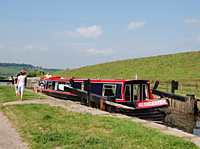
The second way to cross the Pennines twice, by the Rochdale and the Leeds &
Liverpool. There are real contrasts
between the urban centres (some newly
regenerated, and some waiting for that),
and the Pennine crossings, which have
some of the most striking scenery on the waterways.
Leaving our historic canal basin, your journey begins with the
excitement of a new tunnel and the deepest lock in the country.
The canal gradually climbs through woods, fields and small stone
towns to Hebden Bridge. This old mill town nestles in a fork in
the hills, houses piled tier upon tier. Hebden has excellent
shops and is full of surprises – everything from horsey clothing
to hand-made pottery. Untie, and go on up the valley, its sides
closing in with crags and trees and views of the moors high
above. A stream runs alongside, and the locks are set among
woods or stone cottages. The Pennine Way crosses at Callis.
So to Todmorden, completely untouristy yet with much to enjoy –
fine Victorian buildings, especially the Town Hall, a lively
market and many places to eat and drink, all dominated by a
curving railway viaduct. From here the going gets serious – more
Alpine than Pennine. Another 18 locks in just three miles bring
you breathless but exhilarated to the summit, at 600' the second
highest you can scale in England. You will have earned a drink
at the Summit Inn.
From here, you drop down into Littleborough. Pass Clegg Hall, a
Grade 2* listed building dating from 1618, which was long a ruin
but has now been restored. Soon you come to Rochdale itself,
where some of the biggest restoration projects have been
tackled, including the M62, which for so long seemed permanently
to block the canal. Now you go under it by a short but ingenious
deviation of the canal. Then descend through town and country,
transformed by the restoration of the canal, right to the centre
of Manchester. Pubs and restaurants welcome boaters, and the
city is full of life and things to do.
Leave Manchester by dropping under a skyscraper
and taking the last nine locks of the Rochdale to Castlefield,
junction with the Bridgewater Canal. Pass the Trafford Centre
and turn onto the Leigh Branch. Go to Worsley, and stop to see
the birthplace of the canals. Transfer seamlessly to the other
Leigh Branch (you will have to look this up!). This takes you
through to Wigan, where you join the L&L just above the bottom
of the famous flight. Pause to explore the covered market and
bustling town. Set out up the flight, with splendid views back
over the town. Then you are back in the country, with locks at
Johnson's Hill, where the Lancaster Canal never got joined to
the L&L. And so through countryside, with views of the Calder
Valley (that's the Lancashire Calder), interspersed with old
mill towns like Blackburn, you get to Burnley, and cross the
embankment above the rooftops of the town. By now you're getting
the message: the builders of the L&L were astonishingly bold, so
you aren't too surprised, having climbed the deep locks at
Barrowford, to see the long, wide and deep Foulridge Tunnel
ahead of you. You emerge into a pastoral scene, with your first
views of the Yorkshire Dales. After dropping through three
locks, you meander round the hillside on one of the most
isolated stretches of canal anywhere, an extraordinary step out
of modern life. Keep going through Bank Newton and Gargrave
flights, to arrive at Skipton, Gateway to the Dales. Pause to
explore the castle.
A long stretch along the hillside with smashing views and lots
of swing bridges - much easier these days - takes you to the top
of Bingley Five Rise. Now you get more activity, with several
staircase locks taking you down into Leeds, green nearly all the
way into the city centre. Huge investment is transforming Leeds:
you can visit the Royal Armouries, Harvey Nicholls and many
places to eat and drink.
Now you are on the Aire and Calder, a big navigation with
electric locks: you may see some commercial traffic. This takes
you round to Wakefield, where you join the Calder & Hebble
Navigation. This gradually leads you up the valley, the locks
getting shorter and the lock houses smaller as you go. Your
route passes in and out of the river, and has a charm of its
own. Finally the Pennines come into view again, and you know you
are nearly back in Sowerby Bridge.
Navigation notes:
This journey is recommended for experienced crews only. The western half of the Rochdale Canal is not yet in as good condition
as other canals and you may experience difficulty or delays. Some of the
locks can be hard work. We will give further details in the Information Pack posted to
you before your holiday. You must tell us at the time of booking that
you intend to do the Northern Pennine Ring. We will advise on direction of
travel and lock booking.
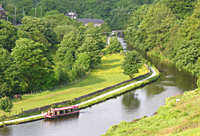 If you are looking for a short break (3 or 4 nights), you have a good
choice
from Sowerby Bridge - but not on this boat. Please search again,
specifying Weekend or Midweek Break, and look out for boats under
Location: Sowerby Bridge.
If you are looking for a short break (3 or 4 nights), you have a good
choice
from Sowerby Bridge - but not on this boat. Please search again,
specifying Weekend or Midweek Break, and look out for boats under
Location: Sowerby Bridge.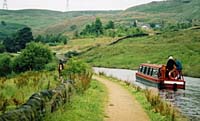 We also offer you a choice of three one-way trips: by the Leeds & Liverpool,
by the Huddersfield Narrow, or by the Rochdale. All provide
unforgettable journeys across the Pennines, and are suitable only for
experienced crews. One way trips are available only on selected boats.
We also offer you a choice of three one-way trips: by the Leeds & Liverpool,
by the Huddersfield Narrow, or by the Rochdale. All provide
unforgettable journeys across the Pennines, and are suitable only for
experienced crews. One way trips are available only on selected boats.
For the Leeds & Liverpool, look under Location: Sowerby Bridge/Barnoldswick for Dorset (4+2 berth).
For the Rochdale and Huddersfield Narrow, look under Location: Sowerby Bridge/Ashton for Cornwall (4+2 berth).